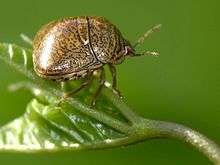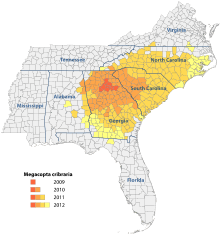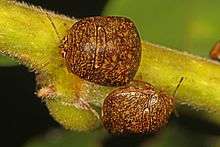Megacopta cribraria
Megacopta cribraria, also called the bean plataspid, kudzu bug, kudzu beetle, globular stink bug and lablab bug, is a shield bug native to India and China, where it is an agricultural pest of lablab beans and other legumes.[1] The bug, while harmless to houseplants and people, often enters houses. It is attracted to white surfaces such as the walls of houses or white vehicles, because of the high reflectance of the white surfaces as it relates to the bugs' simple eyes. As a defense mechanism, they emit a foul-smelling pheromone that also acts as a congregation pheromone. Aside from smelling foul, the liquid also creates a burning sensation and sometimes leaves a red welt on bare skin.[2] It is similar to other Plataspididae in having a somewhat unusual symbiotic relationship with its gut bacteria. Before laying eggs, females deposit particles containing the symbiont, which are then eaten by newly hatched nymphs under natural conditions. Nymphs experimentally deprived of access to the symbiont exhibited slower growth, smaller body sizes and higher mortality.[3]
| Megacopta cribraria | |
|---|---|
 | |
| Scientific classification | |
| Kingdom: | |
| Phylum: | |
| Class: | |
| Order: | |
| Suborder: | |
| Family: | |
| Genus: | |
| Species: | M. cribraria |
| Binomial name | |
| Megacopta cribraria (Fabricius, 1798) | |

The bean plataspid gives off an offensive odor when touched, squashed, or poked. Hosted by wisteria, green beans, and other legumes, the insect sucks juice from the stems of soybean plants and reduces crop yield. However, when the insect infests kudzu, another invasive species, it appreciably reduces the growth of that plant.[2]
Southeastern United States

In the Southeastern United States, M. cribraria is an invasive species, and was first noticed in northeastern Georgia in 2009. As of 2012, it was spreading rapidly into the surrounding states of Alabama, Florida, North Carolina, South Carolina, Tennessee, and Virginia. It has recently begun to invade Maryland and Mississippi, as well. In 2017, M. cribraria was observed in Texas.
Current research
Universities and corporations throughout the Southeastern United States have begun research into alternative means of dealing with the kudzu bug. Universities in Georgia, South Carolina, and North Carolina, such as North Carolina State University and Georgia State University, have produced publications since 2011 until 2014 regarding M. cribraria pest management. One recent work demonstrates that the kudzu bug's diet in Alabama is broader than originally believed.[4]
References
- Dowdy, Sharon (November 10, 2009). "Bug found in Georgia a threat to soybeans?". Southeast Farm Press. Retrieved August 29, 2011.
- Dowdy, Sharon (Aug 29, 2011). "Kudzu bug spreading rapidly across Southern states". Southeast Farm Press. Retrieved Aug 29, 2011.
- Horn, Scott & James L. Hanula (January 2011). "Influence of Trap Color on Collection of the Recently-Introduced Bean Plataspid, Megacopta cribraria (Hemiptera: Plataspidae)". Journal of Entomological Science (Note)
|format=requires|url=(help). 46 (1): 85–87. doi:10.18474/0749-8004-46.1.85. - Riley T. Lovejoy and David A. Johnson (2014). "A Molecular Analysis of Herbivory in Adults of the Invasive Bean Plataspid, Megacopta cribraria". Southeastern Naturalist, Volume 13, Issue 4: 663–672.
External links
- Megacopta cribraria as a Nuisance Pest
- Species Megacopta cribraria - Bean Plataspid on Bugguide.Net
- "Globular Stink Bug Invasive"—Troy Bartlett's Photography Blog: Focusing on Nature's Little Wonders
- Megacopta cribraria on the UF/IFAS Featured Creatures Web site
- Kudzubug.org
- Species Profile - Kudzu Bug (Megacopta cribraria), National Invasive Species Information Center, United States National Agricultural Library.